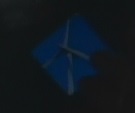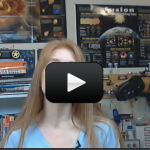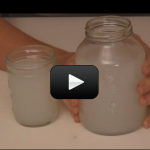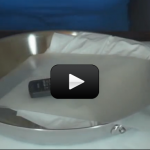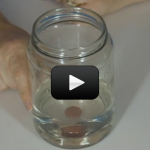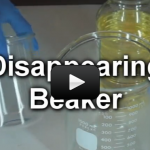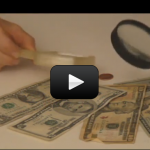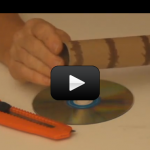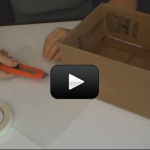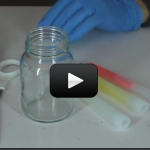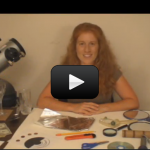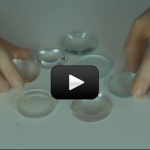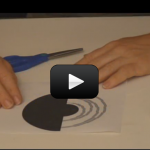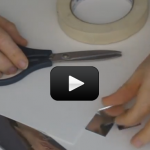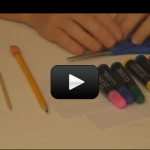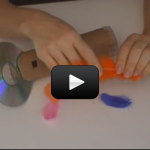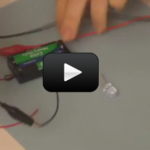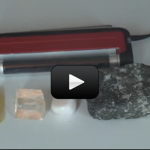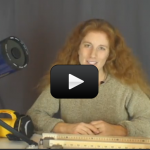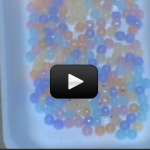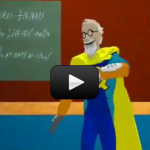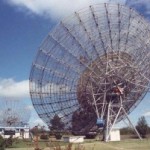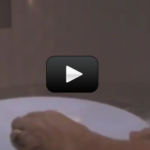3 Polarizer Experiment
Shine a light through polarized sunglasses and the brightness decreases. If you hold two pairs of sunglasses one way, the light then is completely blocked! Not only that, but when you insert a third pair in between the two allows light to pass through again! Spooky! Materials Three pairs of polarized sunglasses (or three lenses … Continue reading "3 Polarizer Experiment" |
Science Teleclass: Light & Lasers & Holograms
This is a recording of a recent live teleclass I did with thousands of kids from all over the world. I’ve included it here so you can participate and learn, too! This class is all about Light Waves, Lasers and Holograms! This is a newly updated version of the older Light Waves and Lasers teleclass … Continue reading "Science Teleclass: Light & Lasers & Holograms" |
Refractive Index
The refractive index provides a measure of the relative speed of light in that particular medium which allows us to figure out speeds in other mediums as well as predict which way light will bend. [am4show have=’p9;p58;’ guest_error=’Guest error message’ user_error=’User error message’ ] Click here to go to next lesson on Disappearing Glass [/am4show] |
Light Speed
Particles that move close to the speed of light have a different equation for momentum in order for momentum to be conserved using Einstein’s relativistic equations. The speeds of large objects like baseballs, bullets, and satellites are so much less than the speed of light so we can use Newton’s equations for it. If you’re … Continue reading "Light Speed" |
Science Teleclass: Light & Lasers
This is a recording of a recent live teleclass I did with thousands of kids from all over the world. I've included it here so you can participate and learn, too! This class is all about Light Waves! Energy can take one of two forms: matter and light (called electromagnetic radiation). Light is energy in … Continue reading "Science Teleclass: Light & Lasers" |
Tech Light Lab Experiments
This set of experiments will show you the properties of light, including optics, diffraction, transmission, reflection, wavelength, intensity, and so much more. You’ll discover how light travels in a straight line, how light can turn a corner, split into several beams, and why objects can appear dark even when light is shining right on them. … Continue reading "Tech Light Lab Experiments" |
Sky in a Jar
Have you ever wondered why the sky is blue? Or why the sunset is red? Or what color our sunset would be if we had a blue giant instead of a white star? This lab will answer those questions by showing how light is scattered by the atmosphere. Particles in the atmosphere determine the color … Continue reading "Sky in a Jar" |
Optics, Fire, and Eyes
If you’ve never done this experiment, you have to give it a try! This activity will show you the REAL reason that you should never look at the sun through anything that has lenses in it. Because this activity involves fire, make sure you do this on a flame-proof surface and not your dining room … Continue reading "Optics, Fire, and Eyes" |
The Dark and Light of Polarization
Polarization has to do with the direction of the light. Think of a white picket fence – the kind that has space between each board. The light can pass through the gaps int the fence but are blocked by the boards. That’s exactly what a polarizer does. When you have two polarizers, you can rotate … Continue reading "The Dark and Light of Polarization" |
How to “See” Infra-Red Light
Crazy Remote Want to have some quick science fun with your TV remote? Then try this experiment next time you flip on the tube: Materials: metal frying pan or cookie sheet TV remote control plastic sheet [am4show have=’p8;p9;p19;p46;p66;p89;’ guest_error=’Guest error message’ user_error=’User error message’ ] Making IR Visible to the Human Eye Infra-red light … Continue reading "How to “See” Infra-Red Light" |
Light Tricks
When light rays strikes a surface, part of the beam passes through the surface and the rest reflects back, like a ball bouncing on the ground. Where it bounces depends on how you throw the ball. Have you ever looked into a pool of clear, still water and seen your own face? The surface of … Continue reading "Light Tricks" |
Disappearing Beaker
We’re going to bend light to make objects disappear. You’ll need two glass containers (one that fits inside the other), and the smaller one MUST be Pyrex. It’s okay if your Pyrex glass has markings on the side. Use cooking oil such as canola oil, olive oil, or others to see which makes yours truly … Continue reading "Disappearing Beaker" |
Microscopes and Telescopes
Hans Lippershey was the first to peek through his invention of the refractor telescope in 1608, followed closely by Galileo (although Galileo used his telescope for astronomy and Lippershey’s was used for military purposes). Their telescopes used both convex and concave lenses. A few years later, Kepler swung into the field and added his own … Continue reading "Microscopes and Telescopes" |
Spectrometer
Spectrometers are used in chemistry and astronomy to measure light. In astronomy, we can find out about distant stars without ever traveling to them, because we can split the incoming light from the stars into their colors (or energies) and “read” what they are made up of (what gases they are burning) and thus determine … Continue reading "Spectrometer" |
Pinhole Camera
This is the simplest form of camera – no film, no batteries, and no moving parts that can break. The biggest problem with this camera is that the inlet hole is so tiny that it lets in such a small amount of light and makes a faint image. If you make the hole larger, you … Continue reading "Pinhole Camera" |
Mixing Cold Light
Here’s a trick question – can you make the color “yellow” with only red, green, and blue as your color palette? If you’re a scientist, it’s not a problem. But if you’re an artist, you’re in trouble already. The key is that we would be mixing light, not paint. Mixing the three primary colors of … Continue reading "Mixing Cold Light" |
Measuring the Speed of Light with a Chocolate Bar
When you warm up leftovers, have you ever wondered why the microwave heats the food and not the plate? (Well, some plates, anyway.) It has to do with the way microwave ovens work. Microwave ovens use dielectric heating (or high frequency heating) to heat your food. Basically, the microwave oven shoots light beams that are … Continue reading "Measuring the Speed of Light with a Chocolate Bar" |
Rainbow Shadows
Imagine you’re a painter. What three colors do you need to make up any color in the universe? (You should be thinking: red, yellow, and blue… and yes, you are right if you’re thinking that the real primary colors are cyan, magenta, and yellow, but some folks still prefer to think of the primary colors … Continue reading "Rainbow Shadows" |
Light, Lasers, and Optics
When I was in grad school, I needed to use an optical bench to see invisible things. I was trying to ‘see’ the exhaust from a new kind of F15 engine, because the aircraft acting the way it shouldn’t – when the pilot turned the controls 20o left, the plane only went 10o. My team … Continue reading "Light, Lasers, and Optics" |
Benham’s Disk
Charles Benhamho (1895) created a toy top painted with the pattern (images on next page). When you spin the disk, arcs of color (called “pattern induced flicker colors”) show up around the disk. And different people see different colors! We can’t really say why this happens, but there are a few interesting theories. Your eyeball … Continue reading "Benham’s Disk" |
Liquid Prism
In this experiment, water is our prism. A prism un-mixes light back into its original colors of red, green, and blue. You can make prisms out of glass, plastic, water, oil, or anything else you can think of that allows light to zip through. What’s a prism? Think of a beam of light. It zooms … Continue reading "Liquid Prism" |
Kaleidoscopes
In a simplest sense, a kaleidoscope is a tube lined with mirrors. Whether you leave the end opened or tape on a bag of beads is up to you, but the main idea is to provide enough of an optical illusion to wow your friends. Did you know that by changing the shape and size … Continue reading "Kaleidoscopes" |
Mixing Colors
There are three primary colors of light are red, green, and blue. The three primary colors of paint are red, yellow, and blue (I know it’s actually cyan, yellow, and magenta, which we’ll get to in more detail later, but for now just stick with me and think of the primary colors of paint as red-yellow-blue … Continue reading "Mixing Colors" |
Diffraction
Ever play with a prism? When sunlight strikes the prism, it gets split into a rainbow of colors. Prisms un-mix the light into its different wavelengths (which you see as different colors). Diffraction gratings are tiny prisms stacked together. When light passes through a diffraction grating, it splits (diffracts) the light into several beams traveling … Continue reading "Diffraction" |
Electric Eye
This is a super-cool and ultra-simple circuit experiment that shows you how a CdS (cadmium sulfide cell) works. A CdS cell is a special kind of resistor called a photoresistor, which is sensitive to light.A resistor limits the amount of current (electricity) that flows through it, and since this one is light-sensitive, it will allow … Continue reading "Electric Eye" |
Black Light Treasure Hunt
Ever notice how BRIGHT your white t-shirt looks in direct sun? That’s because mom washed with fluorescent laundry soap (no kidding!). The soap manufacturers put in dyes that glow white under a UV light, which make your clothes appear whiter than they really are. Since light is a form of energy, in order for things … Continue reading "Black Light Treasure Hunt" |
Advanced Telescope Building
So you’ve played with lenses, mirrors, and built an optical bench. Want to make a real telescope? In this experiment, you’ll build a Newtonian and a refractor telescope using your optical bench. Materials: optical bench index card or white wall two double-convex lenses concave mirror popsicle stick mirror paper clip flash light black garbage bag … Continue reading "Advanced Telescope Building" |
Fun with UV
UV (ultra-violet) light is invisible, which means you need more than your naked eyeball to do experiments with it. Our sun gives off light in the UV. Too much exposure to the sun and you’ll get a sunburn from the UV rays. There are many different experiments you can do with UV detecting materials, such … Continue reading "Fun with UV" |
Quantum Mechanics: Double Slit Experiment
This stuff is definitely sci-fi weird, and probably not appropriate for younger grades (although we did have a seven year old reiterate in his own words this exact phenomenon to a physics professor, so hey... anything possible! Which is why we've included it here.) |
Advanced High School Course in Radio Astronomy
This experiment is for grades 9-12. Radio astronomy is the study of radio waves originating outside the Earth. The radio range of frequencies or wavelengths is loosely defined by three factors: atmospheric transparency, current technology, and fundamental limitations imposed by quantum noise. |
Microwaving Soap
When you warm up leftovers, have you ever wondered why the microwave heats the food and not the plate? (Well, some plates, anyway.) It has to do with the way microwaves work. |

